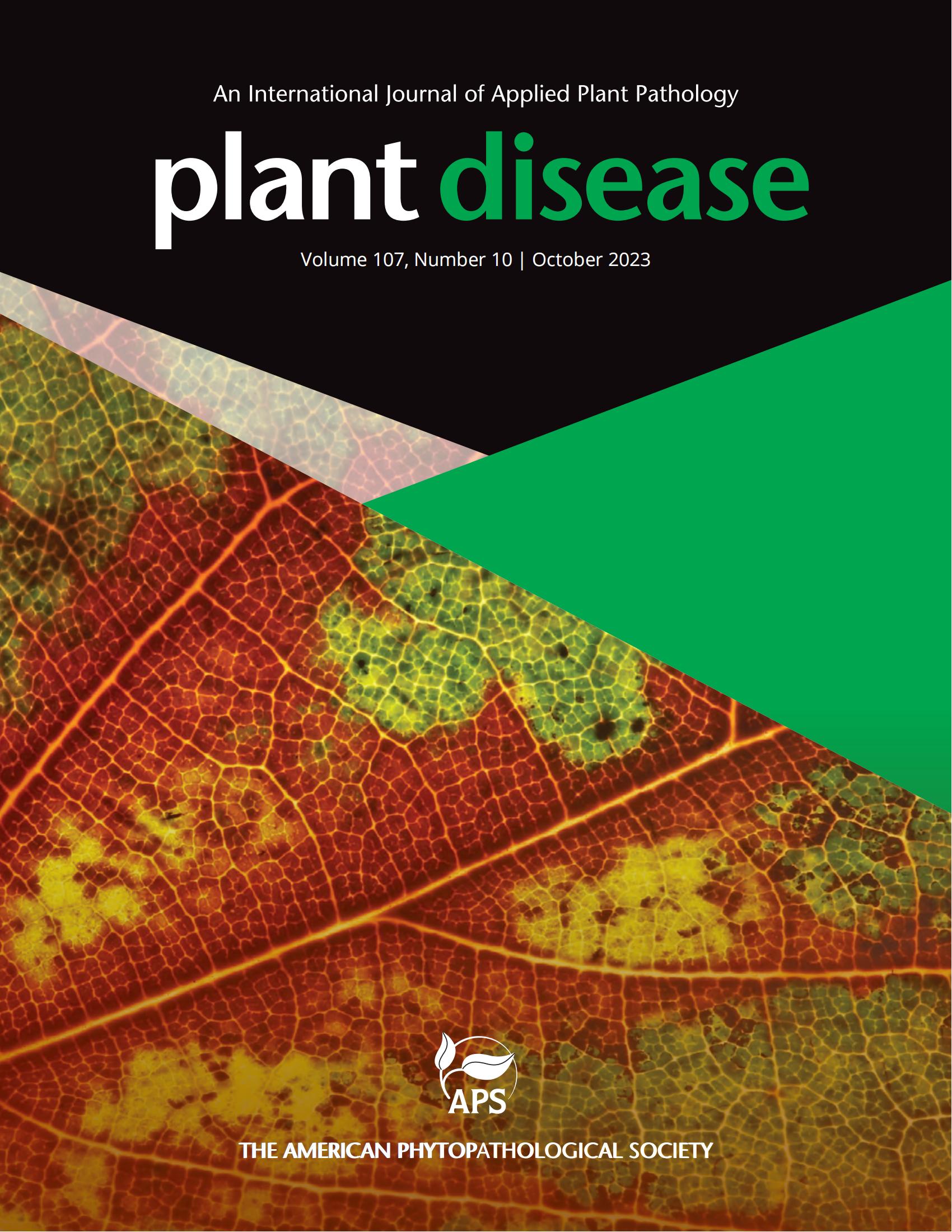甜叶菊是中国与叶斑病有关的 Stagonosporopsis pogostemonis 的新寄主
摘要
甜叶菊(Stevia rebaudiana)是一种前景广阔的药用和食用植物,在中国广泛种植。2022-2023 年,安徽省定远市红星乡(32°34'55″N,118°2'12″E)的甜叶菊发生了新的叶斑病。在三个 S. rebaudiana 苗圃(共 0.1 公顷)中,10% 至 15% 的植株出现了病害症状。典型症状包括叶片上出现黑褐色斑点,叶片枯萎,茎干变褐,顶芽枯死,偶尔出现植株死亡(图 1a)。为了鉴定病原体,采集了 20 片病叶,切成小块,用 75% 的乙醇进行表面消毒 30 秒,再用 0.5% 的次氯酸钠消毒 2 分钟,然后用无菌水洗 3 次,放在 PDA 上,在 25℃下培养 5 天。通过对菌丝尖端进行亚培养,制备纯培养物。获得了 25 个形态相似的拟石蒜孢子分离物。菌落在 PDA 上生长 7 天后,边缘规则,呈棉状,表面形成灰绿色的同心圆。培养物的反面呈深褐色,边缘呈橘黄色和白色相间。在 PDA 上的生长速度为 9.5 毫米/天。分生孢子多为单生,球形或近球形,淡褐色至深褐色,薄壁,无毛,具柄,直径 95.735~250.851×90.93~266.32 μm(n=50)。分生孢子长圆形、圆柱形至椭圆形,壁光滑,无菌,末端圆形,有两个极性菌囊,大小为 3.41 至 5.83 × 1.78 至 3.07 μm(n = 50)(图 1 b-d)。为进行分子鉴定,通过 PCR 扩增了两个代表性分离株(TYJ-SP1 和 TYJ-SP2)的内部转录间隔(ITS)rDNA、大核糖体亚基(LSU)基因、β-微管蛋白(TUB2)基因和 RNA 聚合酶 II(RPB2)基因序列(Woudenberg 等,2009 年;Dong 等,2021 年)。序列已存入 GenBank(登录号:OR506193 和 OR506193):ITS为 OR506193 和 OR506194,LSU 为 OR533526 和 OR533527,TUB 为 OR545221 和 OR545222;RPB2 为 OR545223 和 OR545224),与 ITS 的相似度为 99.60% 至 99.2%(502/504 bp 和 507/511 bp;MZ156571),与 LSU 的相似度为 100% (857/857 bp 和 857/857 bp;MZ191532),与 RPB2 的相似度为 98.67%至 99.3% 的相似性(296/300 bp 和 298/300 bp;MZ203132)和 99.78% 的相似性(888/890 bp 和 868/870 bp;MZ203135)。基于 ITS、LSU、TUB2 和 RPB2 序列的最大似然系统进化分析(MEGA 11.0)表明,TYJ-SP1 和 TYJ-SP2 与 S. pogostemonis 形成一个支系(图 2)。因此,这两株菌株被鉴定为 S. pogostemonis(Dong 等,2021 年)。为了测试致病性,将菌株 TYJ-SP1 接种到 30 天大的 S. rebaudiana 秧苗上,秧苗表面用 70% 的酒精消毒,接种前用水冲洗 3 次并晾干。10 株幼苗喷洒分生孢子悬浮液(105 个分生孢子/毫升),10 株幼苗喷洒无菌水作为阴性对照。所有幼苗均在光周期为 16 小时的生长室(25°C,相对湿度 90%)中养护。接种后 48 小时,在接种叶片上首次观察到褐斑;接种后 7 天出现典型症状。所有接种的植株都出现了与苗圃中自然感染植株相似的症状,发病率达到 100%,而对照植株则没有症状(图 1 e-f)。根据形态学和系统发育分析,从接种植物中重新分离出了相同的 Stagonosporopsis 分离物并进行了鉴定。据报道,S. pogostemonis 可导致卡布其林和甘蓝变种叶斑病(Dong 等人,2021 年;Habib 等人,2024 年)。据我们所知,这是中国首次报道 S. pogostemonis 导致 S. rebaudiana 叶斑病。作为一种药用和经济植物,S. rebaudiana 在中国和其他亚洲国家被广泛种植。叶斑病的发生严重影响了其药用和经济价值。因此,建立和实施有效的病害管理方法以减少该病害的影响至关重要。Stevia rebaudiana is a promising medicinal and edible plant, widely cultivated in China. In 2022-2023, a new leaf spot disease occurred in S. rebaudiana in Hongxing country (32°34'55″N, 118°2'12″E), Dingyuan city, Anhui province. Symptoms were observed on 10 to 15% of plants in three S. rebaudiana nursery beds (0.1 ha in total). The typical symptoms included dark brown spots on the leaves and foliar wilting, the development of brown stems with dieback of top buds, and occasional plant death (Fig. 1a). To identify the pathogen, twenty diseased leaves were collected, cut into small pieces, surface sterilized with 75% ethanol for 30 s, in 0.5% sodium hypochlorite for 2 min, washed three times in sterile water, placed on PDA, and incubated at 25℃ for 5 days. Pure cultures were prepared by subculturing hyphal tips. Twenty-five Stagonosporopsis-like isolates with similar morphology were obtained. After 7 days growth on PDA, colonies had a regular margin, were cottony, and formed concentric circles on the surface that were gray-green. The reverse side of the culture was dark brown with a creme-orange and white, margin. The growth rate was 9.5 mm/day on PDA. Pycnidia were mostly solitary, globose or subglobose, pale to dark brown, thin-walled, glabrous, ostiolate, 95.735~250.851×90.93~266.32 μm (n=50). Conidia were oblong, cylindrical to ellipsoidal, smooth-walled, aseptate, with rounded ends and two polar guttules and measured 3.41 to 5.83 × 1.78 to 3.07 μm (n = 50) (Fig.1 b-d). For molecular identification, the internal transcribed spacer (ITS) rDNA, large ribosomal subunit (LSU) gene, β-tubulin (TUB2) gene and RNA polymerase II (RPB2) gene sequences of two representative isolates (TYJ-SP1 and TYJ-SP2) were amplified by PCR (Woudenberg et al. 2009; Dong et al. 2021). The sequences were deposited in GenBank (accession nos.: OR506193 and OR506194 for ITS, OR533526 and OR533527 for LSU, OR545221and OR545222 for TUB; OR545223 and OR545224 for RPB2) and showed 99.60% to 99.2% similarity to ITS (502/504 bp and 507/511 bp; MZ156571), 100% similarity to LSU (857/857 bp and 857/857 bp; MZ191532), 98.67% to 99.3% similarity to TUB2 (296/300 bp and 298/300 bp; MZ203132) and 99.78% (888/890 bp and 868/870 bp; MZ203135) of S. pogostemonis strain ZHKUCC 21-0001. A maximum likelihood phylogenetic analysis based on the concatenated sequences of ITS, LSU, TUB2 and RPB2 using MEGA 11.0 showed the strains TYJ-SP1 and TYJ-SP2 formed a clade with S. pogostemonis (Fig. 2). Thus, the strains were identified as S. pogostemonis (Dong et al. 2021). To test pathogenicity, the strain TYJ-SP1 was inoculated onto 30-day-old S. rebaudiana seedlings which were surface sterilized with 70% alcohol and washed 3 times with water and air dried prior to inoculation. Ten seedlings were sprayed with a conidial suspension (105 conidia/mL) and ten seedlings were sprayed with sterile water to serve as the negative control. All seedlings were maintained in a growth chamber (25°C, 90% relative humidity) with a 16 h photoperiod. Brown spots were first observed on inoculated leaves 48 h after inoculation; typical symptoms appeared by 7 days post inoculation. All inoculated plants developed symptoms similar to naturally infected plants in the nursery beds, and the disease incidence reached 100% while control plants remained symptom free (Fig. 1 e-f). The same Stagonosporopsis isolates were reisolated from the inoculated plants and identified based on morphological and phylogenetic analyses. S. pogostemonis has been reported to cause leaf spot in Pogostemon cablin and Brassica oleracea var. botrytis (Dong et al. 2021; Habib et al. 2024). To our knowledge, this is the first report of S. pogostemonis causing leaf spot on S. rebaudiana in China. As a medicinal and economic plant, S. rebaudiana is widely planted in China and other Asian countries. The occurrence of this leaf spot disease seriously affects its medicinal and economic value. Therefore, it is crucial to establish and implement effective disease management practices to reduce the impact of the disease.

 求助内容:
求助内容: 应助结果提醒方式:
应助结果提醒方式:


